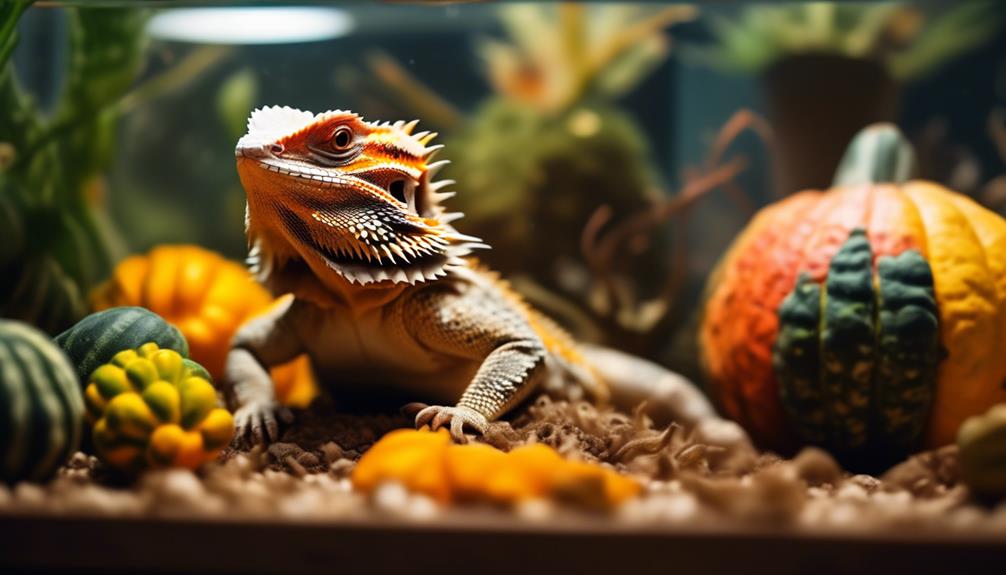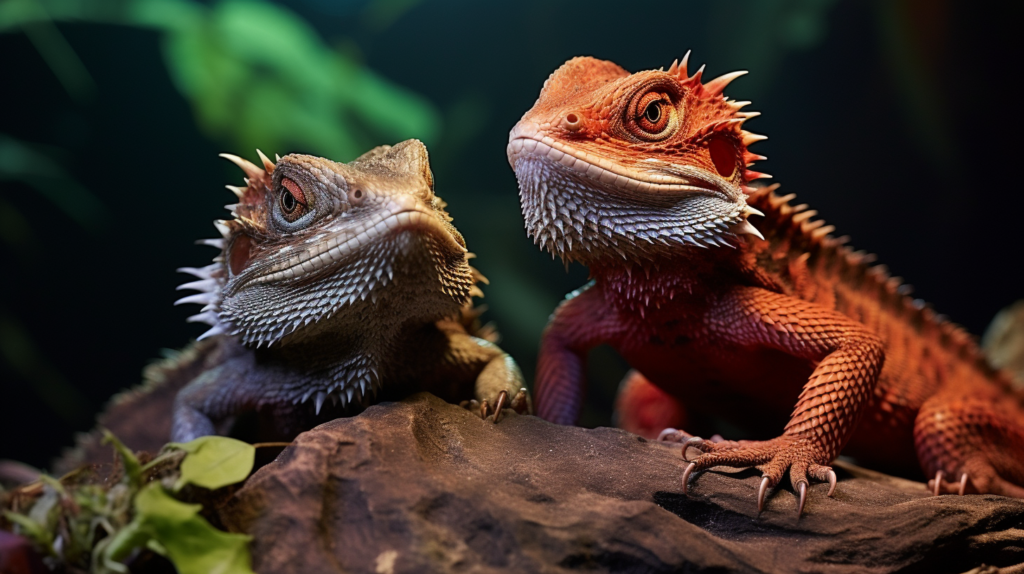You’ve likely heard the saying, ‘You are what you eat,’ and it’s no different for your bearded dragon. When it comes to their diet, finding the right balance of nutrients is crucial.
Now, you might be wondering about the suitability of squash for your scaly companion. While the answer isn’t a simple yes or no, understanding the nutritional aspects and potential risks involved can help you make an informed decision.
Yes, bearded dragons can eat squash, but it should be cooked and served in moderation. Squash offers essential nutrients like vitamins A and C, fiber, and antioxidants, which are beneficial for bearded dragons’ health and well-being.
Nutritional Benefits of Squash for Bearded Dragons
Squash offers a range of essential nutrients that can greatly benefit the health and well-being of your bearded dragon. When considering the nutritional content of squash, it’s important to note that it’s rich in vitamins A and C, as well as fiber. These are all crucial components of a bearded dragon’s dietary requirements.
Vitamin A is essential for maintaining good vision and supporting a healthy immune system. Additionally, it plays a vital role in the growth and development of your bearded dragon.
Vitamin C is a powerful antioxidant that can aid in boosting your dragon’s immune system, helping to keep them healthy and vibrant.
The fiber content in squash can assist with digestion, promoting a healthy gut and preventing constipation.
Incorporating squash into your bearded dragon’s diet can provide a diverse array of nutrients that are essential for their overall well-being. By ensuring that your dragon’s dietary requirements are met, you’re actively contributing to their health.
The nutritional benefits of squash make it a valuable addition to their diet, offering a delicious and nutritious option for serving your beloved pet. Remember to always consider the specific needs and preferences of your bearded dragon when planning their meals, and squash can be a wonderful choice to support their health.
Types of Squash Safe for Bearded Dragons
When considering the nutritional benefits of squash for your bearded dragon, it’s important to be mindful of the types of squash that are safe for their consumption. Not all squash varieties are suitable for your pet, so it’s essential to choose the right ones that align with dietary recommendations for bearded dragons. Here are some squash varieties that are safe for your bearded dragon’s consumption:
- Acorn Squash: This type of squash is a great source of vitamins and minerals, including vitamin A, which is essential for your bearded dragon’s eye health.
- Butternut Squash: Butternut squash is rich in fiber and contains beneficial nutrients like potassium and vitamin C, making it a healthy addition to your bearded dragon’s diet.
- Spaghetti Squash: With its mild flavor and stringy texture, spaghetti squash can be a fun and nutritious treat for your bearded dragon.
- Yellow Squash: Yellow squash is packed with antioxidants and vitamins that can contribute to your bearded dragon’s overall health and well-being.
- Zucchini: Zucchini is a hydrating and low-calorie squash variety that can be offered to your bearded dragon in moderation.
When serving squash to your bearded dragon, ensure that it’s fresh, ripe, and cut into bite-sized pieces to prevent choking hazards. Always monitor their intake and consult with a veterinarian for specific dietary recommendations based on your pet’s individual needs.
How to Prepare Squash for Bearded Dragons
To ensure optimal consumption and digestion, properly preparing squash for your bearded dragon is essential for their health and well-being. Bearded dragons have specific dietary requirements, and providing them with well-prepared squash is crucial for their overall health. Here’s a simple guide to preparing squash for your beloved pet:
| Preparation Method | Description |
|---|---|
| Raw | Peel and remove seeds. |
| Cooked | Boil or steam until soft. |
| Mashed | Mash the cooked squash. |
| Mixed with Greens | Mix with other veggies. |
| Vitamin Supplementation | Add reptile calcium powder. |
When preparing squash for your bearded dragon, ensure that it is thoroughly washed to remove any pesticides or chemicals. If feeding raw squash, peel it, remove the seeds, and cut it into small, manageable pieces. For cooked squash, boil or steam it until it is soft and easy to eat. You can also mash the cooked squash to make it more manageable for your pet. Mixing squash with other greens or vegetables can provide a balanced diet. Additionally, consider adding reptile calcium powder to ensure your bearded dragon receives essential nutrients.
Potential Risks of Feeding Squash to Bearded Dragons
Feeding your bearded dragon squash can pose potential risks if not done with careful consideration of portion size and frequency in their diet. While squash can be a nutritious addition to your bearded dragon’s diet, there are some health concerns and dietary considerations to keep in mind.
- Digestive Issues: Overfeeding squash to your bearded dragon can lead to digestive problems such as diarrhea or constipation. It’s important to moderate the amount of squash in their diet to avoid these issues.
- Nutrient Imbalance: Excessive consumption of squash can lead to an imbalance of nutrients in your bearded dragon’s diet. It’s crucial to ensure that squash is offered in moderation and as part of a varied diet.
- Obesity: Squash is relatively high in carbohydrates, and excessive consumption can contribute to obesity in bearded dragons. Carefully manage the portion size to prevent weight-related health concerns.
- Impact on Calcium Absorption: Squash contains oxalates, which can bind to calcium and hinder its absorption. This can lead to metabolic bone disease if squash is overconsumed over an extended period.
- Allergic Reactions: Some bearded dragons may be sensitive or allergic to squash. It’s essential to monitor your dragon for any adverse reactions after introducing squash to their diet.
To mitigate these risks, it’s crucial to offer squash as part of a balanced and varied diet, ensure proper portion control, and monitor your bearded dragon for any signs of health issues. Always consult with a reptile veterinarian for specific dietary precautions and recommendations for your individual bearded dragon.
Feeding Guidelines and Tips for Squash
Considering the potential risks associated with overfeeding squash to your bearded dragon, it’s essential to establish clear feeding guidelines and tips to ensure their diet remains balanced and healthy. When it comes to squash feeding, it’s important to remember that squash should only make up a portion of your bearded dragon’s diet. While it offers essential nutrients, overfeeding can lead to health issues. Be sure to follow these dietary requirements to maintain a healthy balance in your pet’s diet.
When preparing squash for your bearded dragon, it’s crucial to ensure that it’s fresh and free from any pesticides or chemicals. Thoroughly wash the squash and remove any seeds or skin that could be difficult for your pet to digest. Once prepared, the serving size is equally important. Offer small, bite-sized pieces to prevent choking hazards and monitor your pet’s consumption to avoid overeating.
In addition to squash, your bearded dragon’s diet should consist of various vegetables and insects to provide a well-rounded nutritional intake. A good rule of thumb is to offer squash as part of a salad mix, alongside other suitable vegetables. This variety will help meet your pet’s dietary needs and prevent them from becoming too reliant on a single food item.
Conclusion
So, can bearded dragons eat squash? Absolutely! With its high nutritional benefits and safe options like butternut and acorn squash, it’s a great addition to their diet.
Just be sure to prepare it properly and monitor for any potential risks. With the right guidelines and tips, feeding squash to your bearded dragon can be a healthy and enjoyable part of their diet.
So go ahead and treat your scaly friend to some delicious squash!


